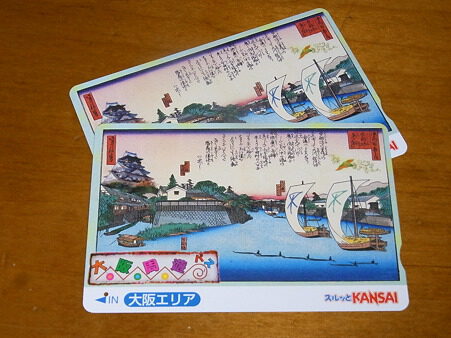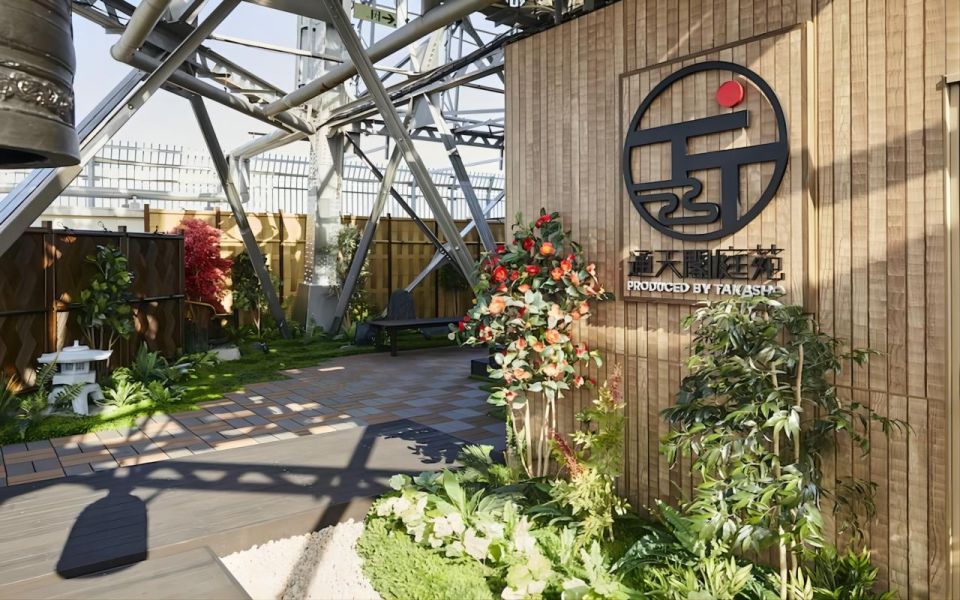
Osaka Castle = Toyotomi family?
Osaka Castle has a strong image of being the residence of Toyotomi Hideyoshi, but in fact, the Osaka Castle built by Toyotomi Hideyoshi does not exist today. In fact, after the destruction of the Toyotomi family in the Osaka Summer Battle, Tokugawa Hidetada carried out major construction work to fill in the existing Osaka Castle, and the current Osaka Castle was completed. Therefore, the current Osaka Castle was built during the Tokugawa Shogunate.
The original Osaka Castle was built during the reign of the Tokugawa Shogunate.
It is said that the original Osaka Castle was built by Toyotomi Hideyoshi with the intention of taking over the country, and was a massive construction project that far surpassed Azuchi Castle.
Construction of the castle began in 1583 on the site of Ishiyama Honganji Temple, and it is one of the largest castles in Japan. On the northern face of the castle, a huge three-story turret looms over the castle, suggesting that the castle was fortified with an iron wall by doubling up the main citadel. Although it looks like a flat castle, the northern side was built on a cliff facing the Yodo River. It is clear that it was built with an attack from the rear in mind.
The castle was built on a cliff facing the Yodo River on its northern side.
The state-of-the-art Osaka Castle
The current Osaka Castle was designed by Takatora Todo. He was a military commander who was considered a master builder of castles. The reason for reclaiming Osaka Castle was not to trample on the Toyotomi family, a negative image, but to meet the requirements of doubling the height of the stone walls and doubling the depth of the moat. Therefore, many of the names of the turrets and gates were taken over from the Toyotomi era, and the castle was rebuilt to be more up-to-date and solid.
Repeatedly burned down
It was Rennyo, a priest of Honganji Temple, who first focused his attention on the land where Osaka Castle was located. He moved Honganji to this site in 1496. Honganji fought Oda Nobunaga for 10 years, but the emperor interceded and Honganji left the area, leaving it in Nobunaga’s hands. During the reign of Toyotomi Hideyoshi, the castle became his headquarters, but when it was destroyed by fire during the Osaka Summer Battle, the Tokugawa Shogunate built a new castle by embankment several meters high on the existing Osaka Castle and reconstructing the castle’s rope line. At the end of the Edo period, Yoshinobu Tokugawa moved in, but the castle was surrendered to the new government forces and the buildings in the back were burned down, and most of the current castle walls have been restored.

Hideyoshi’s grudge?
As the Toyotomi period came to an end and the Tokugawa shogunate came to power, Todo Takatora, a master castle builder, took the lead in building a new castle, but it was often struck by lightning. In particular, a lightning strike in 1660 caused great damage, including a direct hit to the gunpowder storehouse, which blew away about a quarter of the castle.
Furthermore, in 1665, the castle tower was destroyed by fire when lightning struck the golden orca, burning it to the ground in a scene reminiscent of the Osaka Summer Campaign. Moreover, this was the anniversary of Toyotomi Hideyoshi’s death. The people of Osaka called it “Taikoh-san’s grudge” and the castle tower was never rebuilt during the Tokugawa period.
A sense of historical mystery
The Warring States period can be described as a world of mystery, a whirlwind of ambitions from Oda Nobunaga to Toyotomi Hideyoshi and Tokugawa Ieyasu. It is said that the Osaka Castle was built inheriting the will and vision of the monarch Nobunaga, and that the castle was reborn as a new one by the Tokugawa family. Perhaps one key to understanding Osaka Castle is to look at it while thinking about what the warlords of the time thought and dreamed of.
Osaka Castle Highlights

Takatora’s castle-building techniques and the best stone walls in Japan
The greatest highlight of Osaka Castle is its stonewalls, which are 30 meters high. The stonewalls were built by Takatora Todo, who invented the technique of raising the stonewalls directly from the water moat, which I mentioned earlier. The stonewalls of Iga-Ueno Castle, the second tallest, were also built by Takatora, who popularized the stonewalls that extend in a straight line from the water’s surface. The stonewall extends 22 meters from the surface of the water, and on top of that is a 58 meter high structure that includes the castle tower and keep, and considering that the Toyotomi Osaka Castle tower was 36 meters high, it must have been rebuilt on a much larger scale.
The keep is the symbol of Osaka
The keep that is now the symbol of Osaka Castle was rebuilt in 1931 with donations from citizens. With a reinforced concrete foundation, it was the first reconstruction of a mock-up castle tower in Japan. The castle tower withstood the fire of the Pacific War, and today the interior of the castle tower is a museum where valuable exhibits and historical materials related to Osaka Castle are on display.
The castle was built in 1995.
For two years from 1995, the castle was renovated, including earthquake-resistant work, and the damaged roof tiles and outer walls were repainted.
The presence of the restored keep is enough to overwhelm other castles, and you can sense the ambitions and thoughts that were being explored in this area at the time.

Land of Toyotomi’s demise
Although Osaka Castle was reclaimed by the Tokugawa Shogunate, the monument that stands quietly as the final resting place of the Toyotomi family is also worthy of note. It is said that Toyotomi Hideyori and his mother Yododono took their own lives at Osaka Castle while thinking about the revival of the Toyotomi family. Looking at the monument of their suicide, which stands looking up at the castle tower, you can’t help but feel the sorrowful thoughts of Hideyori and his mother and son and the weight of the turbulent history of the castle.

Look for spots you might have missed!
When you look at the finer details of Osaka Castle, you’ll find that there are many remains that remind you of the era and many areas that remain a mystery. In particular, there is a hole in the stone wall facing the outer moat on the south side that looks like a single stone has been removed, and a hole of about 90cm square can be recognized. The depth is about 2m and although the purpose and reason is shrouded in mystery, it is known that the hole was made by the former army in the Meiji period.
Also, on the stairs leading up to the De Masugata from Yamasato Kyurin, there are bullet holes left by American machine gun fire during the Pacific War. It is easy to miss, but these are important remains that must be preserved for future generations.
Cherry blossoms in full bloom in spring
The adjacent Osaka Castle Park is also known as a cherry blossom viewing spot, with approximately 3,000 cherry trees planted in the historic site park. The Nishinomaru Garden is one of the most spectacular. Someiyoshino cherry trees and weeping cherry trees are in full bloom in early April. The weeping cherry is an early bloomer and comes into full bloom a little earlier than someiyoshino, so it is a wonder that just looking at the trunks and branches looks like a work of art.
Osaka Castle photo spots

Recommended times of year
.
If you want to photograph Osaka Castle in a more beautiful way, there are three seasons to aim for: March, April and November, with the ume (plum) groves in March, the cherry blossoms in full bloom in April, and the autumn leaves in January. In March, you can enjoy the ume (plum) grove, in April the cherry blossoms in full bloom, and in January the autumn leaves, each season bringing different changes in the natural environment. There are spots called the “Seven Views of Osaka Castle,” and the view from the Nishinomaru, the top floor of the Osaka Museum of History, and the top floor of the hotel are the best, and many people come here to take pictures in all three seasons.
Let’s photograph these places too
The castle tower, the symbol of Osaka, is an unmissable subject. Looking up from directly below is an option, but you can also capture its beauty from different angles and in different locations. Of course, you should take pictures of the castle keep while taking in the surrounding nature, but you should also take pictures of the engravings and other interesting remains on the stonewalls.
In addition, the monument to Toyotomi Hideyori and Yodo-dono’s suicide is a popular photo spot. There is also a statue of Hideyori at Tamatsukuri Shrine in San-no-maru, where you can remember the young Hideyori who lost his life.
Osaka Castle Access and Recommendations

Osaka Castle Access
To get to Osaka Castle, take the Osaka Loop Line outbound from JR Osaka Station and get to Osaka Castle Park in four stops. The Shinkansen bullet train to Shin-Osaka Station is also easily accessible, taking about 20 minutes. There are also many stations that can be reached on foot, such as Morinomiya Station and Tanimachi 4-chome Station, so it is best to choose the station that best suits your accommodation and the sightseeing spots you wish to visit.
If you are visiting by car, it is convenient to use the Houenzaka and Morinomiya exits of the Hanshin Expressway. Parking for ordinary cars is available at the Osaka Castle Parking Lot (200 spaces) and the Morinomiya Parking Lot (98 spaces), which is open all day long for 350 yen per hour.
Restaurants recommended
Many people visit spots other than Osaka Castle, such as Osaka Castle Park and Osaka Castle Hall, and there are many hotels and restaurants. We recommend Osaka Business Park, which is right next to Osaka Castle Hall. It is full of restaurants and cafes.
There are many hotels and restaurants in Osaka Business Park, which is located near Osaka Castle Hall.
The Panorama Sky Restaurant Asahi on the top floor of the Business Park is an observation spot where you can see almost all of Osaka Castle below. The party room on the south side is recommended, but you have to go in a large group to get in. If you have a small group, you can often be seated on the north side and see the night view at night.
Let’s go up to the castle tower
.
The Osaka Castle Keep has been restored and is a familiar symbol of Osaka. When you visit Osaka, be sure to visit the inside.


